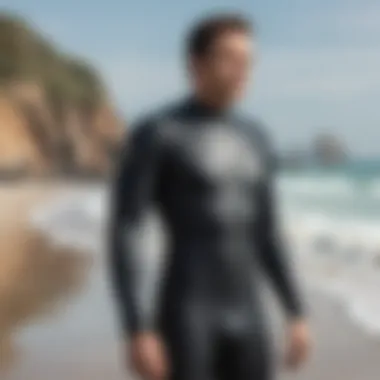Choosing the Best Wetsuit for Larger Men


Intro
Choosing the right wetsuit can be a challenging endeavor, especially for larger males who often find themselves squeezed into options that just don’t fit right. Wetsuits are more than just pieces of rubber; they are essential gear that can make or break an experience on the water. The comfort and safety derived from a well-fitted wetsuit cannot be overstated, as poor fitting can lead to discomfort and even hypothermia when the temperatures drop.
This guide aims to enlighten you about critical factors that play a role in selecting the best wetsuit. Whether you’re planning to ride the waves, kayak in serene lakes, or dive into the deep blue, understanding the nuances of what makes a wetsuit suitable for your size and style is vital. From fabrics that offer flexibility and warmth to features that facilitate movement, all aspects are explored here to provide clarity in your decision-making process.
We will dive into the essentials such as fit, material, thickness, and other characteristics uniquely adapted for larger frames. Moreover, we will discuss how different brands cater to the needs of bigger guys and provide useful tips for purchasing. With this toolkit of information, you will feel empowered to make informed choices — ensuring that your next aquatic adventure is nothing short of exhilarating.
Understanding the Need for Wetsuits
When it comes to engaging in watersports, the right gear can make or break the experience. For larger men, finding a suitable wetsuit is essential not just for comfort but also for safety and performance. Wetsuits are more than just fashion statements; they serve key purposes that enhance enjoyment while tackling waves, diving deep, or kayaking with ease.
Purpose of a Wetsuit in Watersports
Wetsuits provide thermal insulation, buoyancy, and protection from abrasions and UV rays. In cold water, they trap a thin layer of water between the suit and the skin; this water warms up due to body heat and slows down heat loss. For someone with a larger frame, having the correct wetsuit ensures that this insulation is effective throughout the water, thus minimizing the risk of hypothermia.
Moreover, wetsuits increase buoyancy. This feature is crucial for those who may not be as agile in the water. The added buoyancy helps larger individuals float more easily, allowing better movement and reducing fatigue.
Lastly, a wetsuit acts as a safeguard against marine life and environmental factors. Larger men can be more susceptible to scrapes from boards, rocks, or coral. The physical barrier provided by the wetsuit aids in preventing injuries.
Benefits for Larger Men
Comfort: First and foremost, comfort can't be overlooked. A well-fitted wetsuit adapts to a larger body shape by providing room where it’s needed, without being too snug. A poorly fitting wetsuit can lead to chafing and restrictions in movement. It’s imperative for larger men to consider their unique body type when selecting a wetsuit, as comfort directly influences performance.
Increased Confidence: Many larger men feel self-conscious in water sports, especially when comparing themselves to more slender counterparts. A well-fitted wetsuit tailored to a larger frame can help build confidence. When the suit moves with the individual, rather than against them, it reduces distractions and allows focus on the activity.
Enhanced Performance: Larger individuals often possess different strengths and weaknesses in the water. A properly fitted wetsuit can aid mobility and streamline body position, ultimately improving performance in activities such as surfing or swimming.
"Finding the right wetsuit is essential for larger men, as it influences performance, comfort, and safety."
Key Considerations When Selecting a Wetsuit
When it comes to selecting a wetsuit for larger men, there are a number of key factors that one must take into account. This isn’t just about picking out a piece of neoprene to keep warm; it’s about achieving a snug fit that allows for movement, comfort, and ideal thermal protection. A well-chosen wetsuit can be the difference between feeling like a beached whale and gliding through the waves like a seasoned pro. Let's break it down into crucial parts that matter:
Body Measurements and Sizing Charts
Getting the right size is the first step in finding the perfect wetsuit. You can’t just assume that because you’re a certain size in regular clothing, that same size maps perfectly to wetsuit sizing. Many of the brands use unique size charts, often factoring in a combination of chest, waist, and hip measurements, along with height and weight. It’s vital to take accurate body measurements before diving into the purchasing process. Here’s how to do it:
- Chest: Measure around the chest at its fullest point, ensuring that the tape is straight and snug.
- Waist: Measure around the natural waistline, again keeping the tape straight and fitting comfortably.
- Hips: Measure around the widest point of your hips.
- Height: Stand straight against a wall to measure your height from the floor to the top of your head.
With these measurements in hand, compare them to the sizing charts provided by specific brands. If you find yourself straddling two sizes, it’s typically a good idea to opt for the larger size. A wetsuit that’s too tight will restrict movement and lead to discomfort, while one that is too loose may lead to water entering, nullifying the insulation benefits.
Style of Wetsuit: Full, Shorty, or Farmer John
Wetsuit styles can greatly affect both performance and comfort in the water. Larger men should pay attention to the particular needs and types of activities they will engage in. Here’s a quick rundown:
- Full Wetsuit: This style covers the arms and legs completely. Excellent for colder waters, offering maximum insulation and sun protection. Ideal for those planning to be in the water for extended periods.
- Shorty Wetsuit: These are designed with short sleeves and short legs. They provide good flexibility and are perfect for warmer waters, allowing for easier movement, making them suitable for activities like surfing or snorkeling.
- Farmer John Wetsuit: This is a type of full wetsuit but without sleeves, providing easy mobility in the arms while still covering the legs. This style can be particularly appealing for kayaking or paddleboarding.
Choosing the right style comes down to understanding the environment you’ll be in and your personal comfort preferences.
Wetsuit Thickness Options
Wetsuits come in various thicknesses, measured in millimeters (mm). The thickness of the wetsuit is crucial as it determines how warm you will be in the water. Here are some key points to factor in:


- 3/2mm: Best for cool to mild conditions. This thickness strikes a balance between warmth and flexibility, making it popular for surfing in spring and fall.
- 4/3mm: Ideal for colder waters, this thickness provides extra insulation to keep you warm while still allowing for decent mobility.
- 5/4mm or thicker: These are designed for extremely cold water conditions and can sometimes come with additional features like built-in hoods or extra thermal lining for enhanced warmth.
A thicker wetsuit will also generally be heavier, which may affect mobility. It’s essential to consider the water temperature and the duration of your activity when choosing the right thickness.
In summary, when selecting a wetsuit, keep body measurements, style, and thickness at the forefront of your mind. Making informed choices based on these considerations can tremendously improve comfort and performance in the water.
Materials Used in Wetsuit Construction
When it comes to selecting a wetsuit, understanding the materials used in its construction is key. The performance of a wetsuit is often dictated by the kind of material employed, as this can affect warmth, flexibility, and overall comfort. For larger men in particular, who may have different fitting issues, paying attention to these details is crucial to ensure an enjoyable water experience.
Neoprene Types and Their Properties
Neoprene is the primary material used in wetsuits. The various types of neoprene come with distinct properties that may impact performance. For example, standard neoprene offers decent insulation but may not be the most flexible. Alternatively, super-stretch neoprene provides greater flexibility and allows for more movement, which is particularly important when engaging in physically demanding water sports. Larger men might find that a medium thickness of super-stretch neoprene helps them move more freely in the water.
Let's break down some notable types of neoprene:
- Standard Neoprene: Commonly used. Good insulation but relatively stiff.
- Super-Stretch Neoprene: Offers enhanced flexibility. Ideal for active watersports.
- Closed-Cell Neoprene: Provides warmth and buoyancy, suitable for colder water.
- Limestone Neoprene: A more eco-friendly option, made from limestone rather than petroleum. It tends to be lighter and offers warmth similar to that of traditional neoprene.
Each type has its advantages, and understanding these nuances can make a world of difference. Larger men should consider the activities they will engage in while wearing the wetsuit. For example, if surfing is the goal, then flexibility might take precedence over insulation.
Durability vs. Flexibility
Finding a balance between durability and flexibility is another essential consideration. Some might argue that a more flexible wetsuit sacrifices durability; however, that's not necessarily the case. The right materials can provide both benefits, but awareness is necessary when making a choice.
A flexible wetsuit enables then larger man to stretch and paddle without feeling constrained. Conversely, durability ensures that the wetsuit withstands rough use and maintains its function over time. Many high-quality wetsuits offer reinforced seams and special coatings to boost durability without adding bulk.
"A wetsuit should feel like a second skin—comfy, yet robust enough to handle the waves."
The following points summarize how to weigh these two factors:
- Usage Frequency: If you are a frequent user, prioritize durability; otherwise, flexibility might be enough.
- Activity Type: Think about water activities. Surfing may require high flexibility, while diving might benefit from robust materials.
- Price Consideration: Higher-end materials can cost more but often last longer, balancing your investment against durability and flexibility.
By keeping these principles in mind, larger men can choose a wetsuit that not only fits well but also meets their performance needs. A properly constructed wetsuit using high-quality materials will not only enhance comfort but also offer adequate protection, enabling a more satisfying experience in the water.
Fit and Comfort: The Importance of Proper Sizing
Finding a wetsuit that fits well isn’t just about looking good; it’s crucial for performance, comfort, and safety in the water. A suit that is too tight can restrict movements and create unnecessary discomfort, while a loose wetsuit may let cold water seep in, rendering it ineffective. Especially for larger men, these factors become even more pronounced due to variations in body shape and size.
Proper sizing is significant for several reasons:
- Thermal Protection: A well-fitted wetsuit traps a layer of water between the suit and your body. Your body heats up this water, providing insulation. If the suit is loose, this layer doesn't maintain warmth effectively, leading to a chill.
- Mobility: Flexibility is key when engaging in activities like surfing or diving. A snug fit ensures that you can move freely without feeling restricted, allowing you to focus on your performance rather than on discomfort.
- Chafing Prevention: Areas of friction arise when a wetsuit is ill-fitting. Common spots include the collar, armpits, and thighs. A proper fit minimizes these chafing points, helping you to enjoy longer sessions in the water.
How to Try On a Wetsuit
When trying on a wetsuit, there are a few steps to ensure you find the perfect fit:
- Choose the Right Environment: Put the wetsuit on in a space that isn’t too cold. Cold environments can limit your ability to gauge fit properly, as you might feel more constricted.
- Check the Entry: If it’s a front or back zip, make sure you’re comfortable with how to get in and out. Pay attention to how the suit wraps around your frame.
- Assess Movement: Once you’re in the suit, move around a bit. Squat, stretch, and reach to see how the suit conforms. It shouldn’t feel like a second skin, but it shouldn’t be loose either.
- Sit Down: If you’re planning to kayak or surf, sit down in the suit to see how it feels. Sometimes a suit may fit well while standing but not in other positions.
- Ask for Feedback: If you’re unsure, get a second opinion. A friend can help observe how the suit fits in various positions.
Identifying the Right Fit
Once you’ve tried on the wetsuit, it’s important to ensure it’s the right fit:
- Underarms: They should feel snug but not restrictive. You don’t want excess material to cause discomfort while moving.
- Torso: A good wetsuit should fit closely around the torso without leaving excessive gaps. If it feels loose around your midsection, it might not offer proper thermal insulation.
- Legs and Arms: Ideally, the legs and arms should end right at the wrist and ankle with minimal extra fabric. This ensures no water escapes and you maintain maximum control.
- Neck Fit: The neck seal of the wetsuit should feel snug. However, be wary of constriction, as that can lead to discomfort.


"A fitting wetsuit is like a second skin: it offers freedom of movement while still protecting you from the elements."
It's essential to remember that sizing may differ between brands and models. Don’t hesitate to return or exchange a wetsuit if it doesn’t meet your comfort and fit requirements. A quality wetsuit is an investment, and you deserve one that works with you, not against you.
Popular Wetsuit Brands for Larger Men
Finding a wetsuit that fits well is only half the battle; knowing which brands cater to larger men can significantly influence your satisfaction and performance. The importance of exploring popular wetsuit brands lies in their commitment to the unique needs of bigger frames. These brands not only acknowledge the physical diversity among men but also strive to serve this often underserved market. When you're trying to navigate through the vast marketplace, brand reputation and specific model selections can help to simplify your decision-making process.
Brand Reputation and Reviews
When it comes to purchasing wetsuits, the brand you choose can make a world of difference. Top brands cultivate a reputation through consistent customer satisfaction, quality materials, and tailored designs. Generally, reputable brands invest a lot in customer feedback. This is crucial for bigger guys who might find many traditional, popular brands falling short in accommodating their needs.
Some brands garner particularly favorable reviews due to their sizing charts aligning closely with body measurements and providing a comfortable fit. Key factors influencing brand reputation include:
- Construction Quality: Higher-end brands typically use advanced materials and provide longer-lasting products.
- Targeted Sizing: Brands like O'Neill and Xcel have been known to create extended sizes specifically for larger men, ensuring better fit and comfort.
- Customer Service: Companies that are attentive to complaints or inquiries generally cultivate loyal customers.
Many reviews can be found on platforms like Reddit and product-specific forums, which often serve as a treasure trove of experience-based information.
"It's not just about style; it's about feeling comfortable while riding the waves. Pay attention to what others have experienced."
Specific Models Suited for Bigger Frames
In the realm of wetsuits, not every model suits the larger male body type. Certain brands have made it their mission to design cuts and styles that specifically cater to the needs of bigger guys. Here are some recommended models:
- O'Neill SuperFreak Series: This model is constructed with high-stretch neoprene, making it incredibly comfortable for bigger frames. The design allows for a free range of motion, which is critical in water activities.
- Quiksilver Syncro: This wetsuit provides an excellent balance of durability and flexibility. With a range that goes up to larger sizes, it accommodates those who struggle to find fittings in mainstream collections.
- Billabong Furnace Carbon: Known for its exceptional thermal protection, this suit also provides an advanced fit for larger men. Its unique sleeve design is meant to enhance mobility, perfect for any water sport enthusiast.
- Xcel Drylock: This wetsuit is highly rated for its excellent insulation and comfort. Additionally, it offers an array of sizes that include options specifically tailored for larger waistlines and shoulders.
When selecting a wetsuit, always remember that the best fit incorporates both size and personal preferences concerning activity level. Understanding the options available can empower you to make a wise investment that pays off in comfort and performance.
Wetsuit Care and Maintenance
Caring for your wetsuit might not seem like a big deal initially, but in reality, it plays a crucial role in preserving its quality and extending its lifespan. For larger men, finding the right wetsuit is only half the battle. Understanding how to maintain it appropriately ensures you can enjoy your investment for many seasons to come. A well-cared-for wetsuit not only protects your body from the elements while surfing, diving, or kayaking but also maintains its flexibility and thermal qualities—two factors that can significantly affect your performance in water.
Let's break down the two key areas of wetsuit care: cleaning techniques and proper storage methods.
Cleaning Techniques to Ensure Longevity
Keeping your wetsuit clean is essential, particularly since it often takes a dip in salt water or chlorinated pools that can deteriorate the material over time. Below are some effective cleaning techniques to keep your wetsuit in top shape:
- Rinse After Use: As soon as you finish your watersport activity, rinse your wetsuit inside and out with cool, clean water. Doing this helps remove salt, sand, and chlorine. The quicker you rinse it, the less damage you’ll do to the suit.
- Use Mild Soap: If your wetsuit is particularly dirty or has a strong odor, you can use a mild soap specifically designed for wetsuits. Avoid harsh detergents—as they can strip the neoprene of its natural oils and lead to brittleness.
- Gentle Scrubbing: Use a soft sponge or cloth to gently scrub any stubborn areas, but be careful not to pull too hard, as this can stretch the material.
- Air Dry Properly: Avoid hanging your wetsuit directly in the sun for long periods, as UV rays can degrade the neoprene. Instead, hang it in a shaded area or lay it flat to dry.
"Routine maintenance is key to ensure your gear works when you need it most. A little effort goes a long way in extending the life of your wetsuit."
Proper Storage to Prevent Damage
Storing your wetsuit incorrectly can lead to preventable damages that limit its function and wearability. Here’s how to do it right:
- Don’t Fold It: Folding a wetsuit can create creases that may become permanent. Hang your wetsuit on a wide hanger designed for wetsuits. This helps maintain its shape and prevents unnecessary stress on the seams.
- Use a Cool, Dry Place: Store your wetsuit in a cool and dry location away from direct sunlight and heat sources. Excessive heat can break down the materials over time.
- Avoid Confined Spaces: Ensure that the wetsuit has enough space to breathe; cramped places can lead to moisture buildup, resulting in odors and mildew.
- Check Regularly: Periodically check the wetsuit while in storage for any signs of damage or deterioration. This way, you can address potential issues before hitting the water.
In summary, proper care and storage of your wetsuit will not only enhance its performance but also provide you with the comfort and safety needed for your aquatic pursuits. As you gear up for your next adventure, take a moment to consider the little steps that can help your wetsuit stand the test of time.
Common Issues Faced by Larger Men with Wetsuits
Selecting a wetsuit can come with its fair share of hurdles, especially for larger men. These challenges can affect comfort and performance in the water. Understanding the potential issues beforehand can significantly enhance your experience and prevent unnecessary inconveniences.


Chafing and Irritations
Chafing is an unwelcome companion to many watersport enthusiasts, and larger individuals might find this issue pronounced. When the fit isn’t just right, the material of the wetsuit can rub against your skin in a way that causes discomfort. There’s a mix of factors at play here, such as the wetsuit fabric, thickness, and the fit itself.
For those with a fuller physique, seams and areas like underarms or inner thighs can be prime suspects for irritation. The constant movement in the water asserts pressure on these points.
To combat chafing, here are a few practical steps to consider:
- Opt for a wetsuit with flatlock seams. This can help reduce skin irritation compared to traditional seams, providing comfort in crucial areas.
- Look into rash guards. Wearing a lightweight rash guard underneath can act as a buffer against the wetsuit’s material, keeping chafing at bay.
- Test before you commit. Make sure to try the wetsuit in the water. A little bit of hassle during testing now pays off in the long run.
It’s worth mentioning that some irritation can be managed with liberal application of anti-chafing balms.
"The right wetsuit plays a role in your comfort level and overall enjoyment in the water. Neglecting this can turn what should be a great day into a painful experience."
Mobility Restrictions
Mobility is fundamentally vital in watersports. For the active man, any restriction can feel like chains holding you back. A common concern amongst larger males is that wetsuits may hinder natural movement.
When a wetsuit is too tight, it can lead to feelings of restriction, particularly around the shoulders and upper body. This may impair your ability to paddle, swim, or navigate your equipment effectively. Conversely, a suit that is too loose may cause other issues, including increased drag and loss of thermal insulation.
Here are some considerations to improve mobility:
- Choose the right thickness. While thicker materials provide warmth, they can also restrict movement. Measure your expected water temperature and select the suit thickness accordingly.
- Consider wetsuits with stretchy materials. Advanced neoprene types, like super-stretch or compression-fit, can provide more flexibility.
- Trial fitting is crucial. Ensure you can move arms freely and bend at the knees without excessive resistance.
As you navigate through different activities—whether it’s surfing, snorkeling, or kayaking—the importance of mobility cannot be overstated. It’s not just about being in the water; it’s about thriving in it.
Choosing the Right Wetsuit for Different Activities
When it comes to watersports, the right wetsuit becomes a crucial piece of gear affecting performance and enjoyment. For larger men, understanding the specific demands of different activities is vital to choosing a wetsuit that not only fits but also enhances capabilities in the water. A well-selected wetsuit can increase comfort, mobility, and warmth, which in turn maximizes your overall experience. Whether you’re surfing the waves, diving to see the majestic underwater world, or kayaking along a tranquil shoreline, knowing the proper equipment for these activities is essential.
Surfing Needs vs. Diving Needs
Surfing and diving both come with unique requirements that influence wetsuit design and material selection.
- Surfing: When catching waves, a surfer needs a wetsuit that offers flexibility and a snug fit. The focus here lies on agility; movements like paddling, popping up, and controlling the board require a suit that moves with you. A thinner wetsuit, generally around 3/2mm thickness, is often adequate in warmer waters, providing optimal fluidity and ease without compromising warmth too much.
- Diving: On the flip side, diving involves prolonged periods in the water where thermal insulation becomes a priority. A thicker wetsuit, usually 5mm or more, is preferred for diving, especially in cooler waters. The added buoyancy of a thicker suit helps to keep the diver warm. Additionally, durability is essential, as a diver often encounters rough surfaces and potential hazards underwater. A suit should be robust while still providing a degree of stretch to ensure that the diver can maneuver comfortably.
Key Takeaway: Surfing suits prioritize flexibility and lightness, while diving suits focus on insulation and durability.
Kayaking Considerations
Kayaking introduces another angle when selecting a wetsuit. Those who enjoy paddling need to think about movement, comfort, and potentially quick changes in water conditions.
- Mobility: A wetsuit for kayaking should allow for an unrestricted range of motion. You want to paddle effectively without feeling constrained. A shorty wetsuit or a full suit with well-placed seams and panels can often achieve this balance nicely.
- Water Conditions: Unlike surfing or diving, where the environment may call for specific thicknesses based on temperature, kayaking can take you through various conditions. A mid-range wetsuit, somewhere between 3mm to 4mm thickness, is generally a safe bet. It provides warmth without being overly cumbersome when paddling.
- Protection: One must also consider the potential for splashes. A suit that keeps your core warm while shielding your arms from the cold water is optimal. Many kayakers opt for a wetsuit that features a smooth skin exterior, reducing water flow into the suit while paddling.
Ending and Final Thoughts
Choosing the right wetsuit as a larger male goes beyond merely picking a size or style; it’s about enhancing your experience on the water. The right wetsuit can mean the difference between an invigorating day of surfing or kayaking and a frustrating one focused on discomfort. This article has provided a well-rounded exploration of the essential aspects to consider when shopping for a wetsuit tailored to your needs.
When considering a wetsuit, it’s crucial to focus on fit, quality material, and your primary activity. A snug fit will not only help to keep body heat in, but it will also reduce drag while you’re moving through the water. Additionally, understanding the various types of neoprene can guide you in selecting a suit that balances flexibility with warmth. Timing your purchase based on factors such as seasonal sales can also lead to significant savings, making the investment more worthwhile.
Recap of Key Points
- Fit Matters: A properly fitting wetsuit maximizes warmth and mobility, which is essential for performance in the water.
- Material Selection: Opting for high-quality neoprene not only enhances durability but also affects comfort in various water temperatures.
- Activity Alignment: Different watersports require different types of wetsuits, so knowing your primary activity can narrow down your choices significantly.
- Care and Maintenance: Regularly cleaning your wetsuit and storing it properly ensures it has a longer lifespan and remains comfortable.
- Brand Reputation: Researching popular brands that cater to a larger male demographic can save time and offer peace of mind with your purchase.
Encouragement to Explore and Enjoy
Don’t let the challenges of finding the perfect wetsuit dissuade you from enjoying what the water has to offer. Grab your gear, make well-informed choices, and take that plunge into the waves. Whether you’re diving into the surf or floating on a kayak, the right wetsuit can dramatically enhance your experience.
Take time to explore different brands and styles; this journey will not only lead to better gear but also a greater appreciation for watersports in general. Your time spent in the water should be filled with joy, freedom, and adventure, not discomfort. Trust in what you’ve learned here, and don’t hesitate to reach out to communities online, such as on reddit.com, where fellow outdoor enthusiasts can share their experiences and advice.
Ultimately, the right wetsuit awaits.







